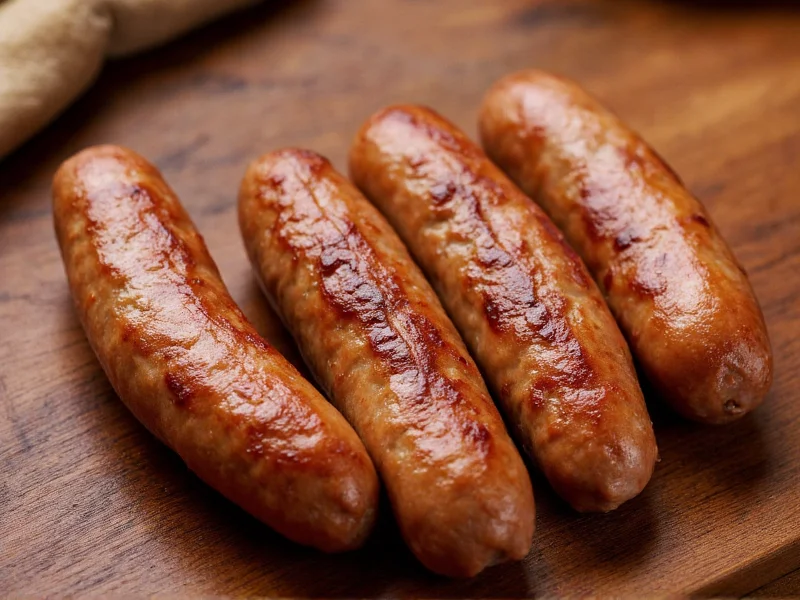Mastering the art of browning sausage transforms this humble protein into a culinary centerpiece. Whether you're working with Italian, bratwurst, or breakfast sausage, proper browning technique creates that desirable caramelized crust while locking in juices. This guide provides professional kitchen insights you can apply at home to achieve restaurant-quality results every time you cook sausage.
Understanding Sausage Varieties and Their Browning Requirements
Sausage comes in numerous varieties, each requiring slightly different browning approaches. Fresh sausages like Italian or breakfast sausage contain raw meat and need thorough cooking, while pre-cooked varieties like kielbasa primarily need browning for flavor development. The fat content significantly affects the browning process—higher fat sausages render more grease, which can be used to enhance other ingredients.
| Sausage Type | Browning Time | Recommended Heat Level | Internal Temperature |
|---|---|---|---|
| Pork Breakfast Sausage | 8-10 minutes | Medium | 160°F (71°C) |
| Italian Sausage | 10-12 minutes | Medium | 160°F (71°C) |
| Chicken Sausage | 10-12 minutes | Medium-Low | 165°F (74°C) |
| Bratwurst | 12-15 minutes | Medium | 160°F (71°C) |
| Pre-cooked Kielbasa | 5-7 minutes | Medium-High | 140°F (60°C) |
The Science Behind Perfect Sausage Browning
Successful sausage browning relies on the Maillard reaction—a chemical process between amino acids and reducing sugars that creates complex flavors and appealing brown color. This reaction occurs most effectively between 280-330°F (135-165°C). Starting with a properly preheated pan ensures immediate sizzle upon contact, which is crucial for developing that desirable crust without overcooking the interior.
Many home cooks make the mistake of using too high heat, which burns the exterior before the interior cooks through. Alternatively, too low heat causes the sausage to steam in its own juices rather than developing that essential caramelization. The ideal approach involves starting with medium heat, allowing the pan to properly preheat for 2-3 minutes before adding the sausage.
Step-by-Step Guide to Browning Sausage Like a Pro
Follow these professional techniques for consistently perfect results when you brown serve sausage:
- Preparation: Remove sausage from refrigerator 15-20 minutes before cooking to take the chill off. Pat dry with paper towels—moisture is the enemy of proper browning.
- Pan Selection: Use a heavy-bottomed skillet (cast iron or stainless steel) for even heat distribution. Avoid non-stick pans for initial browning as they don't develop the fond (browned bits) that adds flavor.
- Heat Management: Preheat pan over medium heat for 2-3 minutes. Test with a drop of water—it should sizzle but not violently evaporate.
- Cooking Process: Place sausages in a single layer with space between them. Resist the urge to move them for 3-4 minutes to allow proper crust development.
- Turning Technique: Rotate sausages 90 degrees halfway through each side to create attractive cross-hatch marks. Turn links every 3-4 minutes using tongs.
- Doneness Check: Use an instant-read thermometer to verify internal temperature. Sausage should feel firm but not hard when pressed.
- Resting: Remove from heat and let rest 3-5 minutes before serving to allow juices to redistribute.
Creative Ways to Serve Browned Sausage
Once you've mastered how to brown serve sausage, elevate your presentation with these serving suggestions that transform simple sausage into memorable meals:
- Classic German Platter: Serve bratwurst with sauerkraut, German mustard, and potato pancakes. The tangy sauerkraut cuts through the richness of the browned sausage.
- Italian-Inspired Meal: Pair browned Italian sausage with roasted bell peppers, onions, and a side of creamy polenta. Add a splash of the sausage drippings to the vegetables for extra flavor.
- Breakfast Power Bowl: Combine crumbled browned breakfast sausage with roasted sweet potatoes, kale, and a poached egg for a nutrient-dense morning meal.
- Sausage Pasta Fusion: Toss sliced browned sausage with whole wheat pasta, garlic, olive oil, and fresh herbs for a quick weeknight dinner.
- Sandwich Transformation: Place browned sausage in a crusty roll with caramelized onions and peppers, then top with provolone cheese for a melted finish.
Avoiding Common Sausage Browning Mistakes
Even experienced cooks make these frequent errors when attempting to brown serve sausage:
- Piercing the casing: Never puncture sausage skins before browning—this releases precious juices and fats that contribute to flavor development.
- Crowding the pan: Overfilling the skillet lowers the pan temperature and causes steaming rather than browning. Cook in batches if necessary.
- Using cold pans: Starting with a cold pan renders fat too slowly, resulting in greasy, unevenly cooked sausage.
- Skipping the rest period: Cutting into sausage immediately after cooking releases juices, leaving the interior dry.
- Ignoring carryover cooking: Remember that sausage continues to cook from residual heat after removal from the pan.
Enhancing Flavor with Sausage Drippings
Don't discard the flavorful fat rendered during the browning process—it's liquid gold for building complex flavors. After removing browned sausage, use the remaining drippings to sauté vegetables, create pan sauces, or deglaze the skillet with wine or broth to incorporate the fond. For breakfast sausage, these drippings make exceptional gravy bases. With Italian sausage, use the fat to sauté garlic and peppers for an instant flavor boost.
Storage and Reheating Best Practices
Properly browned sausage can be stored for future meals. Cool completely within 2 hours of cooking, then store in an airtight container in the refrigerator for 3-4 days or freeze for up to 3 months. When reheating, avoid the microwave which can make sausage rubbery. Instead, warm in a skillet over medium-low heat with a splash of water or broth to restore moisture. For frozen sausage, thaw overnight in the refrigerator before reheating.











 浙公网安备
33010002000092号
浙公网安备
33010002000092号 浙B2-20120091-4
浙B2-20120091-4